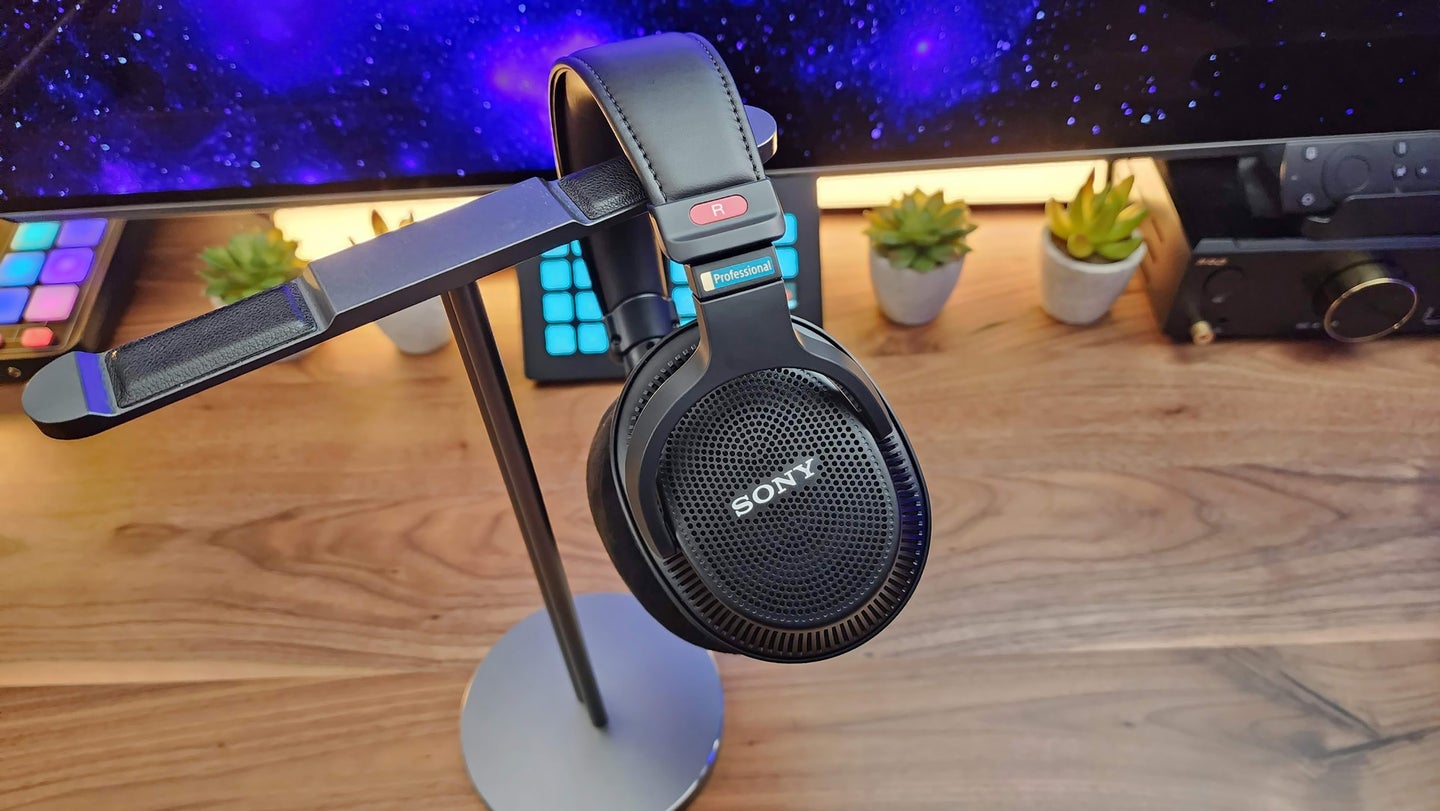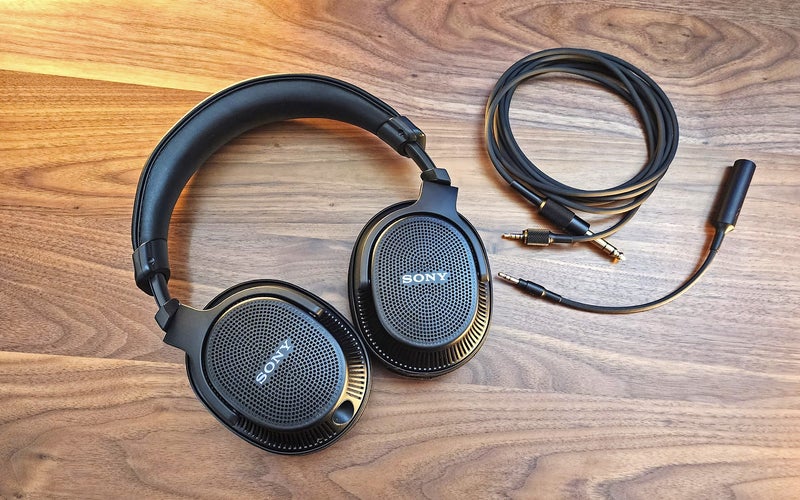The Sony MDR-MV1 is comfortable, balanced, and full of detail to get the most into and out of your tracks new and old.
By
Chris Coke
|
Published Nov 24, 2023 6:00 PM EST

Sony
We may earn revenue from the products available on this page and participate in affiliate programs. Learn more ›
We all love getting lost in our favorite music, but how do mix engineers in the studio keep the frequencies in that music from losing focus? One way is using studio-minded headphones—which is where something like the MDR-MV1, Sony’s latest pair custom-made for sound engineers and industry professionals, come in.
The headphones you love for listening might not be the best for monitoring, and vice versa. You choose the former for their coloration, for whether they emphasize your favorite parts of the audio spectrum, and the latter for whether they manage playback that doesn’t enhance lows and highs for artificial excitement. If you are studio-minded, there are plenty of classic choices to choose from, like the Beyerdynamic DT-1990 or the Sennheiser HD800S, but if you’ve worked around a recording console, the venerable Sony MDR-7506 has surely crossed your radar at some point in time. They’ve been the affordable choice for session musicians and engineers alike for more than 30 years. However, if you loved those headphones but wanted something more recent or higher quality from Sony, you have been out of luck … until now. The MDR-MV1 builds on the design of the MDR-7506 with a decidedly higher quality build and more refined sound. Accuracy and detail are the name of the game for this set, and coupled with its truly exceptional comfort, the Sony MDR-MV1 is a serious contender for recording professionals and audiophiles alike—once you consider certain things.

The build
There are a lot of things to appreciate about the Sony MDR-MV1, and build quality is foremost among them—which you would hope to be true in a $399 headphone. It has an airy fit that first makes you question how well-built it could be and then appreciate it all the more. At only 223 grams, it’s one of the lightest professional monitoring headphones you can buy and comes in around 40% lighter than the venerable DT-1990s and less than half that of the Audeze’s latest mixing cans, the MM-500. Both are among our picks for the best mixing headphones, and I suspect the MV1 will soon find its place alongside them.
What makes its light mass so remarkable is that Sony has incorporated a plentiful amount of aluminum into its design rather than the pure plastic of the MDR-7506—a headphone that is heavier than the MV1. The earcups and headband are both metal, with intricate holes milled in the cups to enable their open-back design. The impressive detail is the kind of design you’ll only appreciate more the closer you look. More importantly, the headphones have a robustness you can feel with minimal handling. A drop when reaching across the mixing board shouldn’t slay these headphones. It’s a workhorse headphone if I’ve ever seen one.
Though the carved-out cups have a unique aesthetic, these aren’t headphones that scream “audiophile” in the artsy way fancy planar magnetics and higher-end dynamics sometimes do (I’m looking at you, Dan Clark Stealth and HIFIMAN Audivina). Apart from the perforated cups, they have a very restrained, professional look. Matte black across the board, slim and low-profile fabric cushions, red and blue channel stamps: the MV1 follows the same design as other Sony engineering cans, so will be right at home in any commercial or bedroom studio.
Internally, the headphones use specially designed low-distortion 40mm dynamic drivers with custom-shaped and corrugated diaphragms to deliver their sonic experience. With an ultra-wide frequency response of 5Hz to 80,000Hz, they can accurately reproduce the entire range of human hearing (and beyond) with exceptional clarity and low distortion. The open-back design of the headphones naturally reduces reflections within the housings that might otherwise impact dynamics (and requires you to use them in a controlled, low-noise environment), but Sony has also added acoustic dampeners throughout the structure to silence them further. This creates a directionality to the flow of soundwaves from the back of the headset, improving its spatial accuracy.
 The open-back design of the MV1 is the key to these headphones’ sound.
The open-back design of the MV1 is the key to these headphones’ sound.
This is important because these headphones have been designed with more than stereo mixing in mind. Spatial audio is on the rise across the headphone industry (delivered via Dolby Atmos by Apple and as “360 Reality Audio” on Sony products), and being able to mix for spatial dynamics accurately is more important than ever. These headphones must (and do) excel in monitoring accuracy and deliver an exceptional yet accurate, not exaggerated, sound field. It’s a consideration that older generations of closed-back mixing headphones didn’t have to factor in but is an active element of the Sony MV1’s design, developed in conjunction with Sony’s 360 Virtual Mixing Environment (360VME) service.
Though sound is clearly the most important element of any pair of headphones, comfort is a close second when you’re wearing them all day. Their low weight, breathable velvety cushions, and well-balanced clamp force make them a treat to wear. Top-of-head soreness is a real issue with heavier headphones, but hot spots aren’t a concern here. When you need a break, the ear cups pivot to rest around your neck and are slim enough not to bump your chin. The only criticism I might levy against them is that the pads are a bit thin, which left my ears touching the inner fabric of the cushions. Even so, I could wear these for the better part of an entire workday without any discomfort whatsoever and could have continued doing so had the day gone longer.
 Plush-yet-lightweight cushions are key for comfort during all-day listening sessions.
Plush-yet-lightweight cushions are key for comfort during all-day listening sessions.
There’s no storage case included with the headphones, which is a bit disappointing for their price, but it does come with an excellent cable. At just over eight feet long, it provides the freedom of movement necessary to navigate the studio. It screws into the left ear cup, so you won’t need to worry about untimely snags pulling it free. It’s also delightfully soft with virtually no cable memory. It falls straight, wraps straight, and isn’t prone to tangling, which is just about perfect as far as cables go. It terminates in a standard 6.35mm connection to interface with most audio gear, but Sony also includes a 3.5mm adapter for use with laptops and portable DACs that may lack the bigger port.
Overall, the Sony MDR-MV1 is a remarkably well-built, well-designed, and exceptionally comfortable pair of headphones. Audiophiles may find themselves wishing for a shorter cable, but it’s safe to say that Sony knocked it out of the part with its design and wearability.
The sound
As a longtime veteran of the bedroom recording scene, I’ve recorded with enough gear to know what makes a great pair of monitoring cans, and the MV1 has it. The sound is balanced but not neutral to the point of anemic. It’s energetic but not sharp, spacious but not extravagant. It’s a headphone designed for accurate monitoring and reproducible results and delivers on that promise.
Accuracy, in this case, doesn’t mean a completely flat frequency response, but it does mean a balanced and revealing one. There’s a delightful body to the sound—primarily in the mid- to upper-bass, as sub-bass is limited by the nature of open-backs—which allows instruments and percussion to present fully without being magnified. It’s more punch than slam but delivers even at low listening levels, which is impressive. Meanwhile, the mids, where much of a mix is clustered, are slightly forward and smooth without being glossy, maintaining the detail needed to sculpt space for each stem. Vocals are ahead in the way a singer may stand in front of a band to lead a live show—engaging and immediate but not overwhelming. The crisp highs allow upper harmonics to sound and instruments to ring out with true-to-life timbre, helping you spot imperfections.
The spatial presentation is exceptionally well-balanced. I admit, my first impression was one of disappointment … until I listened further. These headphones don’t deliver the width of a great set of audiophile cans, but they do deliver separation between the instruments needed to carve frequencies and ensure imaging. There’s a depth to the listening experience, an easy perceptibility of layer upon layer, coming together to create a track. Each is discernible with even casual listening. If something is off, you’ll hear it in an instant. Stereo imaging is also excellent with excellent directional cues and clear panning between each channel.
 The headphones’ 40mm drivers produce smooth mids that are especially impressive when listening to vocals.
The headphones’ 40mm drivers produce smooth mids that are especially impressive when listening to vocals.
My personal ah-ha moment came between recording a sample track and listening back in my car. This, I’ve learned over years of home recording, is one area where monitoring failures become apparent. I’ve had mixes that sounded great in my headphones suddenly sound alternatively bloated and muddy or shrill and grating in the car. The game of cat and mouse chasing these shortcomings down, remastering, and relistening can extend to multiple repeats and lost hours if not for a great pair of studio headphones.
The MV1 nailed the mix on the first try. There’s enough bass to match a master in a realistic listening environment. There’s enough treble to hear accuracy in tone and the minute details of a performance. The mids are centered, balanced, and presented with an eye to rendering a final product. It’s not perfectly neutral but transparent nonetheless.
What’s especially magic about these headphones is that the tuning manages to be enjoyable even if you never plan to mix a single track. Audiophiles will find a lot to love here. Its low-end response and relative fullness compared to a set like the beyerdynamic DT-990 PROs make it a genuinely fun set to get lost with. Zach Bryan’s “Something in the Orange” was atmospheric in a way I had never appreciated before, and the balance between vocals and acoustic guitars was enrapturing. These are headphones to mix and appreciate mixes with.
 Building on a strong foundation, the MV1s impressed each time I put them on.
Building on a strong foundation, the MV1s impressed each time I put them on.
The conclusion
The Sony MDR-MV1 is an evolution. It applies the lessons learned from generations of Sony MDR studio monitors and addresses concerns levied at some of its most dominant competition. It’s lightweight and comfortable and won’t leave your head sore. Its transients soar but aren’t egregiously sizzling. It offers depth and space but isn’t unrealistically wide. And just as importantly as its response is energetic and immersive when the mix calls for it, it’s flat-out fun to listen to when away from the faders. While it’s hundreds more than its closed-back precursor, it’s reasonably priced compared to direct competitors. And, because it doesn’t go for the unerring analytical response inspired by a traditional studio monitor, it’s better prepared for localizing objects and the (re)creation of songs in virtual surround. Put succinctly, these headphones are a well-rounded win and are well worth the investment for engineers and audiophiles alike.

>>> Read full article>>>
Copyright for syndicated content belongs to the linked Source : Popular Science – https://www.popsci.com/gear/sony-mdr-mv1-headphones-review/































